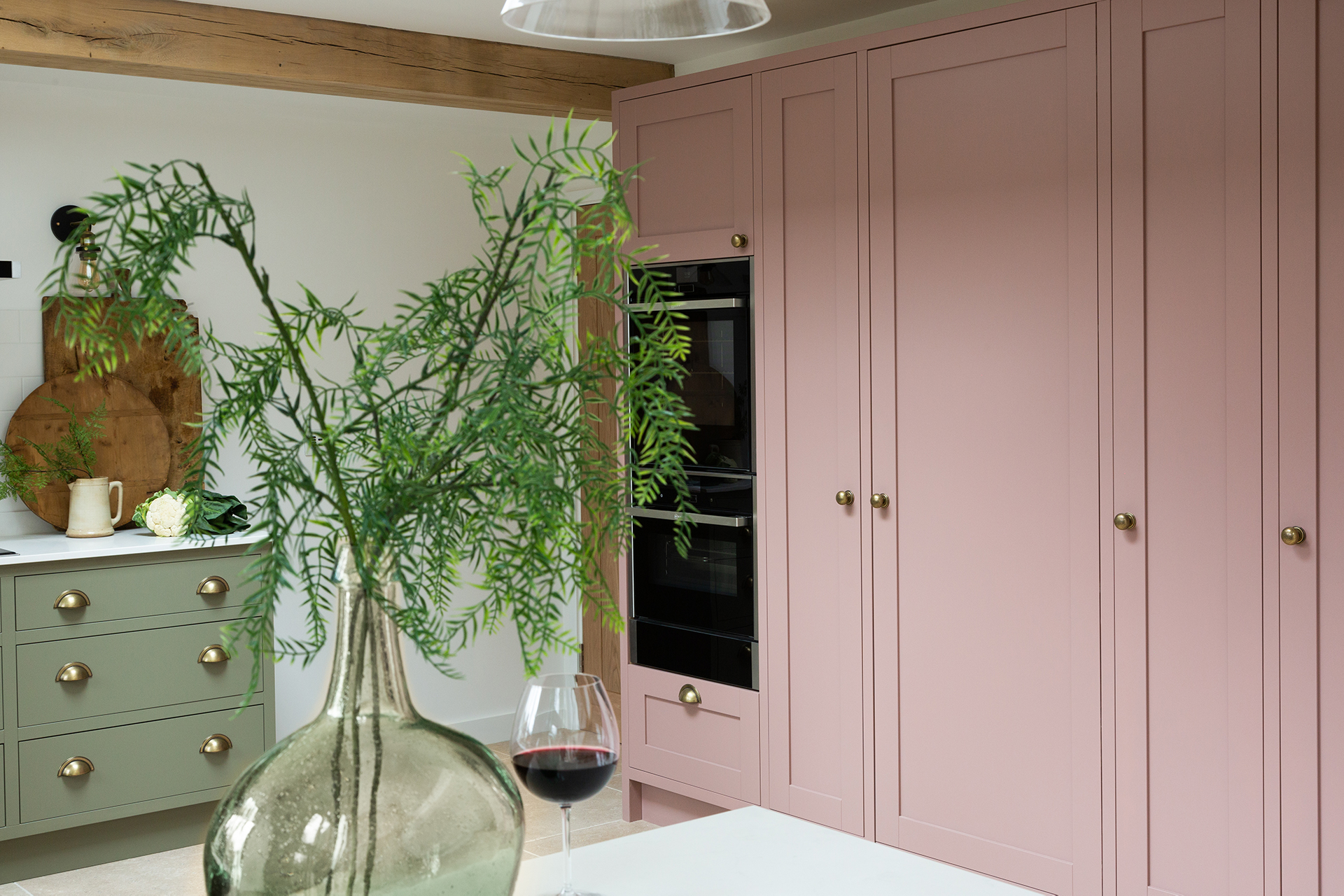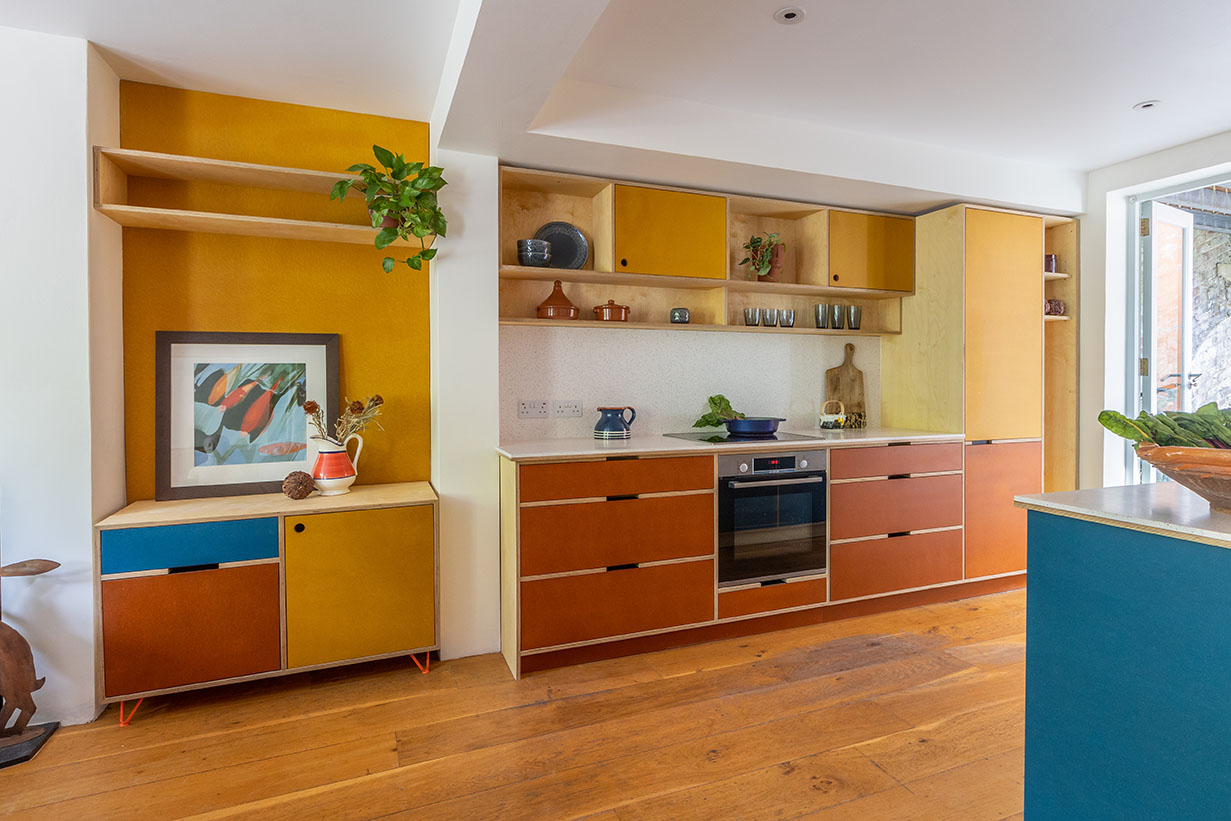Coloured kitchen units: hand-painted vs. Valchromat doors
If you’ve got specific kitchen unit colour ideas in mind, you might be disappointed by the limited choices offered by many of the big name suppliers.
Mass-produced kitchens tend to be restricted to certain colours (as well as the usual range of wood finishes). Typically, with standard coloured kitchen doors, you’ll be looking at ‘safe’ neutrals like grey, black, navy, cream or white – maybe green.
We’d never knock your colour choice. There are many creative ways to make a neutral-coloured kitchen sing – just take a look at our glam and gothic Kano design (painted in moody blue-black ‘Railings’ by Farrow & Ball).
However, because we create completely bespoke designs, we can offer total freedom when it comes to the colour – and pattern – of your kitchen units.

Image: Kano – Farrow and Ball painted kitchen
Hand-painted kitchen cabinets vs. Valchromat kitchen doors
Colourful kitchen design can be a great way to inject your personality into your home. However, it is important to choose the right materials in order to achieve the desired aesthetic.
In this blog we’ll take a look at two of the most popular options for a striking and colourful kitchen: hand-painted units vs. Valchromat kitchen cabinets.
Why choose hand-painted kitchen cabinets

Image: Luanda painted kitchen
Pros of hand-painted kitchen cabinets
•Endless colour options
When you opt for a painted kitchen, you can choose from a huge range of colour combinations. From subdued and subtle – like our Luanda kitchen in soft sage and pink (above) – to the most vivid brights in our geometric Kolwezi kitchen (below).
•Customisation
A painted kitchen gives you the option of many different surface finishes, from matte to high gloss.
•Cost-effective
Painted fibreboard or plywood cabinets can be a more budget-friendly option.
•Changing your coloured kitchen cabinets
If – years further down the line – you decide to revamp your colourful kitchen, it can be repainted in a different colour palette.
Cons of a hand-painted kitchen
•Durability
Painted kitchen units may get scratched or chipped with daily wear and tear.
•Maintenance
Although we recommend finishing with a protective sealant, there is still the potential need for touch-ups and repainting due to damage or general wear.
•Environmental impact
Some types of paint aren’t especially good for the environment, nor are certain types of fibreboard that are commonly used for painted cabinets. However, at Wood Works Brighton we always encourage the use of low or no-VOC eco-friendly non-toxic paint. In addition, we tend to use timber – typically birch plywood – from FSC-certified sources.

Image: Kolwezi – a painted kitchen
Why choose Valchromat kitchen doors
Valchromat is an innovative wood fibre panel. It combines many of the natural features of wood and is available in a range of bright and vibrant colours. Because the fibres have been dyed throughout the material – described as ‘through core’ colour – it can be worked in three dimensions.
Having been coloured with organic dyes, it is bonded together with a special resin. The way it is engineered gives Valchromat unique physical and mechanical features. It is moisture-resistant and strong yet flexible, making it ideal for achieving a colourful kitchen design.

Image: Tanta – a modern Valchromat kitchen
Pros of Valchromat kitchen doors
•Choose from a rich colour palette
Valchromat is available in a selection of vibrant colours. The organic dyes and fibrous texture mean that it has a certain tonality – it is not always a uniform colour.
•Durable
Valchromat is renowned for its strength and resistance to wear and tear, making it ideal for high-traffic areas like kitchens. It is – on average – 30% stronger than MDF.
•Versatile
As well as cabinetry and doors, Valchromat can also be used for countertops. Its solid colour distribution means that surface scratches are harder to see compared to products that are painted.
•Sustainable and safe
Valchromat is an environmentally friendly non-toxic substance made from recycled pine wood and mill waste. Unlike MDF, Valchromat does not contain formaldehyde or toxic chemicals in its bonding resin. Dyes are organic and non-toxic, meaning that Valchromat is even used for the manufacture of children’s toys.
•Surface options
Valchromat can have a matte, high gloss/lacquer, varnished, waxed or oiled finish.
Cons of Valchromat kitchen cabinets
•Cost
Valchromat may be pricier than traditional painted fibreboard options.
•Limited colour options
The range of colours could seem limited, when compared to the huge selection of paint choices that are available.
•Installation
Valchromat can be more complex to work and install than painted finishes (but we’re very experienced with both, so it’s not a problem!). In fact, due to its composition, Valchromat is easier to cut and causes less damage or degradation to blades.
Hand-painted vs. Valchromat kitchen doors?
When deciding between Valchromat and hand-painted kitchen cabinets, your main considerations are likely to be:
- Budget
- Your overall aesthetic and preferences
- Maintenance and longevity
- Environmental impact
We can discuss all of the above at your initial design consultation.
Experts in colourful kitchen design
Having considered the pros and cons of hand-painted wood vs Valchromat kitchen doors, you may be wondering: what next?
If you’re interested in discussing your kitchen unit colour ideas and how we can take them further, please click to secure an initial design consultation with the team here at Wood Works Brighton.
In the meantime, you may be interested to see our recent work showcased on our Instagram account, for more home design inspiration.
